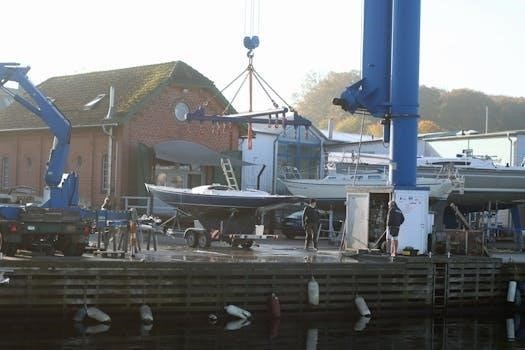Understanding Boat Lift Guides
Boat lift guides are essential for safe and efficient boat handling․ They assist in aligning the boat correctly during loading and unloading․ These guides also prevent damage to the vessel and lift‚ especially in challenging conditions with waves or currents․
Boat lift guides are crucial components of any boat lift system‚ designed to aid in the safe and precise maneuvering of boats onto and off the lift․ They are especially beneficial in areas with fluctuating water levels‚ currents‚ or waves‚ where precise alignment is crucial․ These guides come in various forms‚ including posts‚ bunks‚ and catwalks‚ each serving a unique purpose․ Properly installed boat lift guides not only protect your boat from damage but also enhance the overall efficiency of the lifting process․ They minimize the risk of misalignments‚ which can lead to costly repairs or accidents․ The use of boat lift guides ultimately contributes to a more secure and convenient boating experience‚ ensuring that your vessel is handled with care every time it is lifted or lowered․ They provide a visual and physical framework‚ making the process smoother and more reliable․
Purpose of Boat Lift Guides
The primary purpose of boat lift guides is to ensure the safe and accurate positioning of a boat onto a lift․ These guides act as a visual and physical aid‚ assisting the boat operator in aligning the vessel correctly‚ thus preventing damage to both the boat and the lift structure․ They are particularly vital in areas with strong currents‚ waves‚ or fluctuating water levels‚ where maintaining precise control can be difficult․ Furthermore‚ boat lift guides streamline the loading and unloading process‚ making it more efficient and less stressful for the user․ They minimize the risk of collisions‚ scratches‚ and other damage that can occur during boat handling․ Properly installed guides also reduce the potential for accidents‚ contributing to a safer boating environment․ Ultimately‚ their purpose is to enhance the usability and reliability of boat lifts‚ ensuring a smooth and protected experience for boat owners․

Types of Boat Lifts and Their Guides
Boat lifts vary widely‚ including vertical‚ elevator‚ bottom-standing‚ piling mount‚ floating‚ and shore-mounted options․ Each lift type requires specific guide systems to ensure proper boat alignment and safety during operation․
Vertical Boat Lifts and Guide Systems
Vertical boat lifts are designed to raise a boat straight up out of the water‚ making them ideal for areas with fluctuating water levels․ These lifts typically utilize a top beam made of steel or aluminum‚ which spans between pilings to support the vessel’s weight․ The guide systems for vertical lifts often include guide posts or bunks that help center the boat as it’s being raised or lowered․ These guides are critical for preventing the boat from colliding with the lift structure and ensuring a smooth‚ controlled movement․ The guide systems can be customized with options like carpeted bunks or adjustable posts to accommodate various boat hull shapes and sizes․ Proper alignment and safe boat loading is ensured with a good guide system‚ also preventing damage when the lift is in operation․
Elevator Style Lifts and Guides
Elevator style lifts are uniquely designed for narrow canals or docks with limited space․ Unlike traditional lifts‚ they employ forklift-like arms that extend out to support the boat․ These arms are attached to a mechanical system on pilings or the dock․ The guide systems for elevator lifts are usually integrated into these arms‚ often consisting of adjustable bunks or padded supports that cradle the boat’s hull․ These guides ensure the boat is lifted evenly and remains stable throughout the process‚ preventing any side-to-side movement during lifting․ Due to the restricted space‚ guides are crucial for precise positioning and also for protection․ These lifts are a practical solution for areas where space constraints pose a challenge for standard boat lifts․ The guides work to safely and effectively secure the vessel․
Bottom Standing Lifts and Guides
Bottom standing lifts are popular for their versatility and cost-effectiveness․ They feature a rectangular metallic frame that rests on the lake or sea floor‚ using four corner posts for support․ The guides for these lifts often include adjustable bunks or guide posts that are mounted on the frame․ These guides help to center the boat as it is moved onto the lift․ They also prevent the boat from drifting or colliding with the lift structure․ These guides are crucial for safe and easy loading‚ especially in areas with fluctuating water levels․ Bottom standing lifts also use additional guides‚ such as carpeted load guides‚ to provide a soft contact point․ These guides protect the boat’s hull from scratches or damage․ They also ensure precise positioning on the lift platform․
Piling Mount Lifts and Guides
Piling mount lifts are designed to be attached to existing pilings‚ making them ideal for docks with established support structures․ These lifts use a top beam to span between pilings‚ which also houses the drive units and cable winders․ The guides for piling mount lifts are typically installed on the lift’s frame‚ or on the pilings themselves․ They often consist of guide posts or bunks that are adjustable‚ allowing them to fit various boat sizes․ These guides are essential for precise boat alignment during loading and unloading․ They help prevent the boat from hitting the pilings or the lift mechanism․ Piling mount lifts also use guide-ons to protect the watercraft․ These ensure proper positioning and safe operation of the lift․ The guides work together to provide stability and prevent damage․

Floating Lifts and Guides
Floating boat lifts are designed to rise and fall with the water level‚ making them suitable for areas with fluctuating tides or water levels․ These lifts are often constructed with a buoyant platform that supports the boat․ The guide systems for floating lifts are critical for maintaining stability and ensuring the boat is correctly positioned․ These guides typically include posts or bunks that are mounted on the lift’s platform‚ or sometimes on adjacent structures․ These guides help the boat to move smoothly‚ preventing any impact with the lift or the surrounding area․ They also assist the boat during loading‚ keeping it on track as it moves onto the lift․ Floating lifts often require additional guides to manage lateral movement‚ especially in choppy waters․ This is crucial for safe and consistent boat handling․
Shore Mounted Lifts and Guides
Shore-mounted boat lifts are designed to be installed on the shoreline or a dock‚ offering a stable platform for lifting boats out of the water․ These lifts often feature a frame that extends from the shore‚ supporting the lifting mechanism․ The guide systems for shore-mounted lifts are crucial for directing the boat onto the lift safely․ Typically‚ these guides consist of posts‚ bunks‚ or a combination of both‚ mounted on the lift’s frame․ These guides help to align the boat as it approaches the lift‚ preventing misalignment and potential damage․ They ensure the boat is positioned correctly before being raised․ The guides must be robust to withstand the weight and movement of the boat‚ and they are often adjustable to accommodate different boat sizes and hull configurations․ Some shore-mounted lifts also incorporate guide-ons to assist in maneuvering the boat onto the lift‚ particularly in windy conditions or currents․

Selecting the Right Boat Lift Guides
Choosing the correct boat lift guides involves assessing boat size‚ weight‚ and environmental conditions․ Consider guide options like posts‚ bunks‚ and catwalks for safe and efficient boat handling․
Factors to Consider When Choosing Guides
Selecting the appropriate boat lift guides requires careful evaluation of several factors․ Firstly‚ the size and weight of your boat are paramount; larger‚ heavier boats will need more robust guide systems․ The hull type and configuration of your boat also play a crucial role‚ as different hull designs may require specific guide shapes or materials․ The environmental conditions of your location are also important; areas with strong currents or frequent waves might need sturdier‚ taller guides‚ or carpeted load guides․ Frequency of boat usage should be considered‚ as guides must be able to withstand regular use․ Whether the lift is for residential or commercial use is also important‚ as commercial applications may need more durable options․ Finally‚ ensure the chosen guides are compatible with your specific lift type‚ whether it’s a vertical‚ elevator‚ or another style․ Considering these elements ensures the chosen guides are effective and provide long-term protection for your vessel․
Guide Options⁚ Posts‚ Bunks‚ and Catwalks
Boat lift guides come in several forms‚ each serving unique purposes․ Guide posts are a common option‚ typically vertical poles that help align the boat as it enters the lift․ They are useful for simple guidance and are often adjustable to suit different boat sizes․ Bunks‚ on the other hand‚ are horizontal supports that cradle the boat’s hull‚ providing a more secure fit and preventing the boat from shifting․ Bunks may be carpeted to protect the boat’s finish․ Catwalks are walkways adjacent to the lift that allow for easier access to the boat when it’s on the lift․ Catwalks provide a safer way to move around the boat‚ which is very useful for maintenance․ Some lifts combine posts and bunks to offer both guidance and support․ Choosing the right combination will depend on the vessel and personal preferences․ Consider the specific needs of your boat when choosing․
Boat Size and Compatibility with Guides
Selecting the correct boat lift guides involves considering your boat’s dimensions․ The length‚ beam (width)‚ and weight of your boat are critical factors․ Guides must be appropriately sized to accommodate your boat without being too restrictive or too loose․ Overly tight guides can damage the hull‚ while guides that are too far apart may not provide sufficient assistance․ For smaller boats‚ simple guide posts or bunks might suffice․ However‚ larger boats often require a more robust system‚ possibly including catwalks for easier access and secure positioning․ It’s essential to verify that the guides are rated for the weight of your boat‚ especially if they are designed to support the vessel as well as guide it․ Always refer to the manufacturer’s guidelines to ensure compatibility and proper functionality․ If needed‚ a dealer can provide assistance․

Installation and Use of Boat Lift Guides
Proper installation of boat lift guides is crucial for safety and effectiveness․ Correct usage ensures smooth loading and unloading․ Regular maintenance extends the life and reliability of the guides‚ enhancing boat lift operation․
Installation Tips for Boat Lift Guides
When installing boat lift guides‚ begin by carefully measuring your boat’s beam to ensure proper spacing․ Use the manufacturer’s instructions to position the mounting hardware securely․ Ensure that all connections are tightened correctly‚ but do not overtighten․ Adjust the guide posts or bunks so they are aligned with the hull of the boat․ Verify that the guides are level and parallel to each other․ For carpeted guides‚ ensure the material is in good condition․ If using guide-ons‚ make sure they are attached firmly and provide adequate clearance for your boat․ Check the guides before each use to ensure they are securely mounted and free of obstructions․ Regularly inspect for wear and tear‚ and replace any damaged parts promptly․ Proper installation is key to safe and effective boat lift operation․ Consider professional installation for complex setups or if you are unsure of the process․
Using Guides for Safe Boat Loading and Unloading
When loading your boat‚ approach the lift slowly and carefully‚ utilizing the guides to center the vessel․ Align your boat with the guides‚ allowing them to direct the hull into the correct position․ Maintain a slow speed as you move onto the lift‚ avoiding any sudden movements․ Once the boat is centered‚ proceed with lifting․ For unloading‚ lower the boat slowly until it is floating freely․ Use the guides to keep the boat straight as you exit the lift․ Be mindful of wind and currents‚ which can affect boat alignment․ Always check that the boat is securely positioned before raising or lowering․ Ensure that passengers are clear of any moving parts․ If using catwalks‚ use them for safe access around the boat․ Consistent and careful use of guides will greatly enhance safety and prevent damage to your boat and lift․
Maintaining Boat Lift Guides
Regular maintenance of your boat lift guides is crucial for their longevity and effectiveness․ Inspect your guides frequently for signs of wear‚ damage‚ or corrosion․ Check all mounting hardware to ensure it is tight and secure․ For carpeted guides‚ look for tears or fraying‚ replacing them as needed to avoid scratching your boat․ If your guides are made of metal‚ check for rust and apply a protective coating if necessary․ Clean the guides regularly‚ removing any debris or buildup․ Ensure that guide posts are vertical and firmly attached․ Lubricate any moving parts as recommended by the manufacturer․ Consistent care will prevent future problems and ensure the guides operate smoothly․ Neglecting maintenance can lead to premature failure and potential damage to your boat․ Proper maintenance enhances safety and prolongs the life of your boat lift system․
